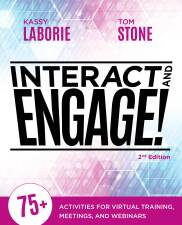ATD Blog
Develop Your Relationship and Tech Skills to Deliver Effective Virtual Events
Tue Sep 27 2022


Virtual learning experts Kassy LaBorie and Tom Stone understand that the need to interact and engage is more important than ever, as online collaboration becomes the norm rather than the exception. In the updated edition of Interact and Engage!, they offer tips and strategies to help you create effective online learning and masterful meetings and webinars. Activities range from warmups and icebreakers to closers and celebrations, and everything in between. In this interview, LaBorie and Stone share some insights on what readers can expect to learn in the book.
When you initially wrote Interact and Engage, the virtual training/meeting landscape was very different than it is now. What have you learned in between writing the first and this edition?
Kassy: The virtual training skills we have worked on building for years are needed now more than ever before. These skills apply not only to how we engage learners, but how we conduct our digital lives today. It used to be we’d spend time helping people build skills for “if” they would take their training online and why they should waste no more time and do it right away! Today, it is no longer if, but rather, “next time.” The conversation today is focused entirely on the next time you are training and meeting online, so here are things you can do to build your skills and become more effective at creating and delivering engaging experiences.
Tom: Yes, the landscape is very different today, in that virtual training, meetings, and webinars are so much more common, particularly since 2020. And the platforms and add-on technologies have continued to progress as well. But the core needs of everyone involved—participants, facilitators, producers, and designers—have remained fundamentally the same. So, in this second edition we remained focused on providing key skills and tips and a now expanded cookbook of activity recipes that you can use to boost the engagement and effectiveness of your online events.
You were early adopters of virtual training, which has now become nearly required for business to operate. What would you tell people who are still wrestling with the efficacy of virtual engagement?
Kassy: Virtual engagement is more about relationships, connections, and authenticity than it is technology. Technology is simply the vehicle enabling the connections. Reframing our mindset this way, being present for and with people, and ensuring we use technology that doesn’t get in the way of our purpose, is the key to engagement, whether it’s virtual or not. Work on viewing the technology not as something separate, but rather, as something “normal.”
Tom: Like any skill, facilitating, producing, or designing for online interaction is a skill you need to learn and practice. Kassy has been doing this for more than 20 years, and I’ve been focused on this area for more than 10. What she emphasized is correct, with the analogy being that with in-person presentation or facilitation, it isn’t the room, slides, or flipcharts that makes a meeting or training session effective. Focus on design and include activities where appropriate so that attendees become active participants, and then practice your skills so that the technology shifts from being an obstacle to being the background environment—just like the room or stage are for in-person events.
Regarding virtual training specifically: What are your observations about the adoption of the virtual classroom? And what are the key hurdles you see people trying to overcome?
Tom: As we shared in the book, research we conducted in partnership with the Institute for Corporate Productivity (i4cp) found that the virtual classroom is here to stay. Organizations are going back to some level of in-person training, but many programs that were redesigned for online from 2020–2022 are going to remain online. Some benefits have always been obvious—such as increased scale and some degree of cost savings (for example, when travel is not needed). But some barriers to virtual training have also been reduced or eliminated (for example, the same research from i4cp found that in many cases the effectiveness of online training is on par, or at times higher than, similar in-person training). The most mature organizations and training teams now have two comfortable and strong options available.
Kassy: If we think about the past few years, for many, adoption (of virtual training) was out of necessity. It was more about usage than pure adoption, and there seemed to be a sense that soon things would change, so let’s just get this over with so we can get back to “normal.” However, as time went on, usage wasn’t enough. People wanted to be good at using it; they wanted to be skilled and effective. Also, it became increasingly clear we had missed opportunities to connect with more learners, in the moment of need, and expand our reach by adopting a digital approach.
Considering these realizations, four key hurdles people continue to overcome today are changing their mindsets, building virtual facilitation skills, designing for a virtual experience, and investing in effective technology. Thinking positively rather than assuming online is “less than” remains a key challenge as we continue to navigate changes in demands and workplace expectations, especially pertaining to not only being online, but also connecting in hybrid environments. Trainers need to practice facilitating online, rather than continuing to present information. Managing the amount of content being delivered is a hurdle to facilitation because of the time it takes to involve everyone.
A thoughtful approach to the design of a virtual instructor-led program is important. Lecturing information is faster; stopping to ask questions, allowing discussions, and facilitating activities takes time. The design needs to take all of this into account.
And lastly, assuming all technology is created equally or that we can “make do” with any technology is simply not true. Choosing the proper tool, with a variety of effective, accessible, and user-friendly features helps people overcome the first hurdle. Often, online training is seen as less effective when it is the technology that is lacking.
We seem to be in a push-pull reality when it comes to hybrid work. Is hybrid work here to stay? If “yes,” what are the top three things talent development professionals and managers need to know to create a learning environment that fosters engagement?
Kassy: Hybrid work is certainly here to stay. The newly realized benefits far outweigh the desire to ever return to any situation that does provide at least some degree of flexibility. Talent development professionals and managers need to focus on user-friendly technology that includes the features necessary to do more than present information to an audience. They will fare well to work on building trust and relationships with people. For virtual training sessions in particular, adopt an “online first” approach where the digital activities, access, and engagement techniques are designed first and then adapted for the in-person experience as needed.
Tom: I agree with that point because it is human nature to slip into focusing on what is in front of you. In the common hybrid scenario where the facilitator is in the room with some people, and then others are attending virtually, the tendency would be to favor in various ways the in-person audience. Instead, we need to design the event, even design the room, for the people who are not there—the people who are online.
This is all assuming that you’ve made the decision to attempt to hold a hybrid learning event at all. Remember, just because you have a hybrid audience does not mean you need to have a hybrid event. You might decide that the advantages of the online platform (for example, using chat to allow for a back-channel “chatversation”) are strong enough to have everyone, no matter where they are located, attend equally as individuals in the online environment.
This approach can often be both easier and more effective than attempting a “hybrid” training event. You can also experiment with introducing some in-person elements, such as having the in-person participants gather together in a room for their “breakout” group activities.
What are the top skills people need to have to be effective in a virtual environment today and in the future?
Tom: The top skills people need to be effective in the virtual environment today fall into three main categories that we’ve outlined in the book: Technical, Presentation, and Facilitation.
Kassy: After coaching people for many years, it is these three areas that are the most different from training and meeting in person, as well as the most challenging for people to master. An example of building technical skills includes the ability to learn the features of any platform and be able to use it naturally, so that it does not get in the way of the purpose of the training or meeting.
Advancing your virtual presentation skills includes paying attention to not only how you appear on camera but also, how the design of the visuals being shared also engages an online audience to action. Preparing slides and screen shares to involve an audience, rather than to simply show them is key to effectiveness.
And this connects nicely to the ability to facilitate in a virtual environment, an environment which easily lends itself to showing, but not so much to doing. There are some simple ways you can improve your facilitation skills, such as giving participants “purposeful silence,” so they have time to formulate an answer. Also, be clear in providing direction in how you’d like them to respond; I call this “tacking on the tech,” for example, “Using the chat, please indicate whether you agree or disagree.”
About the Authors
Kassy LaBorie is founder and principal consultant at Kassy LaBorie Consulting. She is a virtual classroom master trainer specializing in developing trainers to be engaging and effective when facilitating programs in Zoom, Webex, Adobe Connect, and other online platforms. She has worked with many Fortune 500 firms in a wide range of industries and sectors, including hospitality, pharmaceuticals, energy, government, NGOs, and nonprofits. She is a sought-after speaker for industry events like the ATD International Conference & EXPO, ATD TechKnowledge, Training magazine’s conference, TechLearn, Learning Solutions, and DevLearn.
Prior to launching her consulting practice, Kassy was the director of virtual training services at Dale Carnegie Training, a consulting service that partnered with organizations to help them develop successful online training strategies. She was also the product design architect responsible for developing the company’s live online training product and experience, which grew to be a $4 million business in only a few years.
Tom Stone joined i4cp as a senior research analyst in 2017. Since then, he has led major research studies on workforce readiness, hybrid and remote work, leadership behaviors, succession management, automation and AI, and other topics. He is also heavily involved with i4cp’s chief learning and talent officer board and i4cp’s workforce planning exchange.
Tom has more than 20 years of experience in the learning and development and broader human capital industry. Prior to joining i4cp, he was director of technology-based learning at Dale Carnegie Training, where he led the product development for their virtual training and other digital offerings. Earlier in his career, he served as a senior research analyst at talent management software provider Taleo, and he held various positions, including product design architect and content development manager, at e-learning provider Element K.
Interact and Engage, 2nd Edition: 75+ Activities for Virtual Training, Meetings, and Webinars
ISBN: 9781953946409| 302 Pages | Paperback
td.org/book/interact-and-engage-2nd-edition
To order books from ATD Press, call 800.628.2783.
To schedule an interview with any of the authors, please contact Kay Hechler, ATD Press senior marketing manager, at [email protected] or 703.683.8178.
You've Reached ATD Member-only Content
Become an ATD member to continue
Already a member?Sign In
